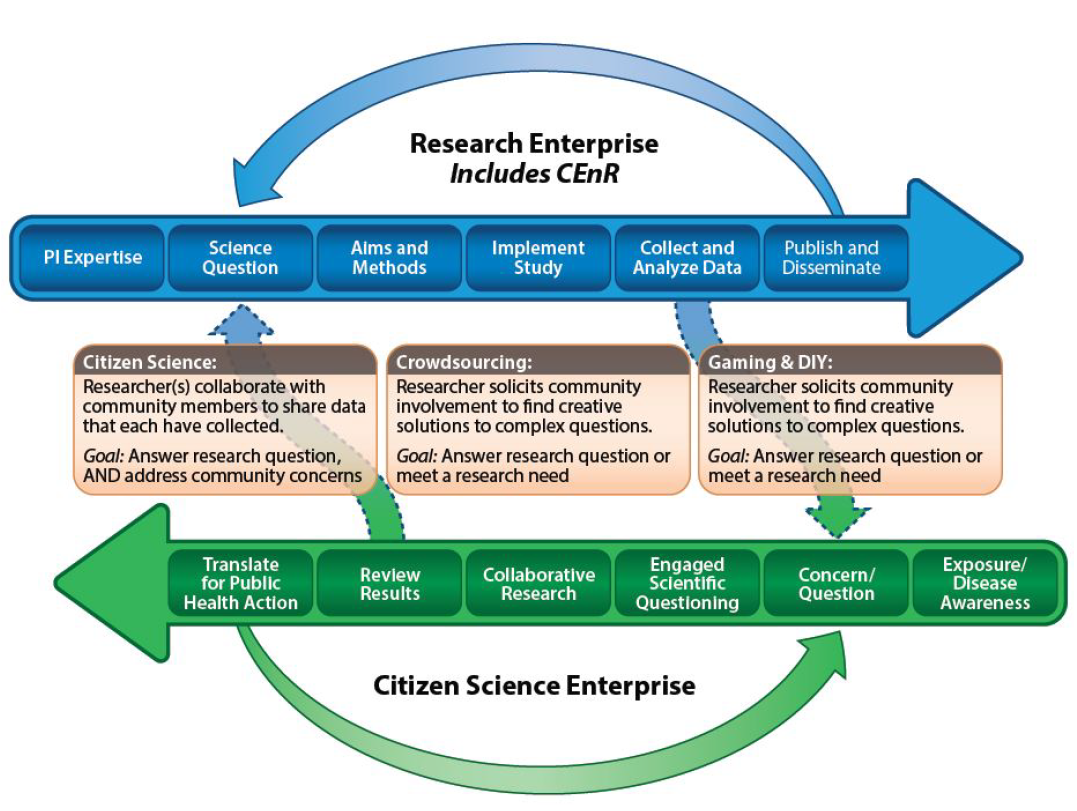NIEHS has long supported community participation in the research process, and continues to encourage new research approaches that foster collaboration between communities and scientists while building capacity to address environmental health concerns. The institute is also actively involved in recent federal efforts aimed at encouraging the use of citizen science.
Collaborations between citizens and researchers can take many forms along a continuum of public engagement in scientific research. NIEHS program officers Liam O’Fallon and Symma Finn have developed a conceptual framework (see figure) that illustrates the similarities and differences between community-led citizen science efforts and academically-driven research projects. It also shows how these enterprises act to support each other. Collaborative research approaches highlighted within this framework include:

A full-sized version of this image (166KB) is also available.
Community-engaged research (CEnR). CEnR projects are driven by academic concerns. A scientist or research team engages the community to help develop research questions, design a study, and collect data. The goal is to answer a scientific question or meet a specific research need.
Citizen science. Citizen science efforts are driven by community concerns. These community-led projects may involve a partnership with an academic or research institution, where both parties work together to collect and share data. The goal is to address a community concern through collaborative research, and to translate the research findings into public health action that benefits the community.
How are CEnR and citizen science being used to address environmental health concerns?
- Alaska Community Action on Toxics (ACAT)
- Environmental Health for Alabama Communities (ENACT)
- Gardenroots: Measuring arsenic in gardens near a hazardous waste site
- Grand Lake Watershed Mercury Study
- Gulf Coast Health Alliance: health Risks related to the Macondo Spill (GC-HARMS)
- HAPI: Putting Community Engaged Research into Action to Address Childhood Asthma
- Imperial County Community Air Monitoring Project
- THE (Trade, Health, Environment) Impact Study
- UPROSE: Community-Engaged Research for Climate Change Adaptation and Resilience
- West End Revitalization Association: Demonstrating the Value of Community-led Research to Address Environmental Justice Issues
Resources
- Citizenscience.gov
- Citizen Science and Community-Engaged Research in Environmental Public Health
- Community Engaged Research Training
- NIH Citizen Science
- Research Triangle Environmental Health Collaborative 2016 Summit Recommendation Document
Publications
- Averett N. 2017. New blood: the promise of environmental health citizen science projects. Environ Health Perspect 125(11):112001. [Full Text Averett N. 2017. New blood: the promise of environmental health citizen science projects. Environ Health Perspect 125(11):112001.]


